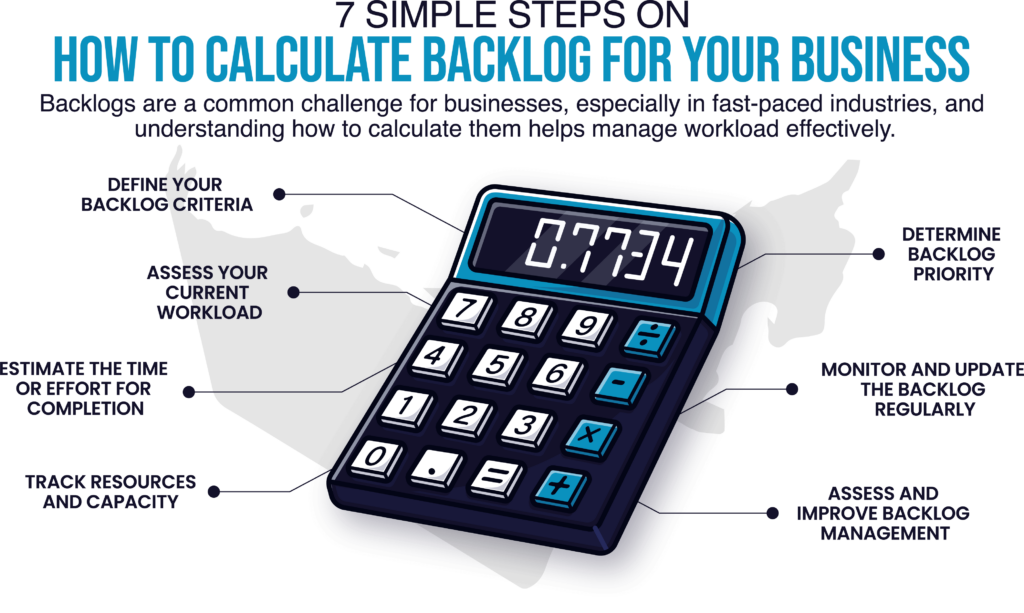7 Simple Steps on How to Calculate Backlog for Your Business

Define Your Backlog Criteria
By defining your backlog, you set clear parameters for what you’re tracking and ensure that you focus on the most critical elements that impact your business operations.
Once you clearly define your backlog you can set the parameters. These tracking parameters keep your focus on only the most relevant aspects of the project.
Assess Your Current Workload
For calculating your backlog you’ll need to assess your current workload. Analyze the number of tasks, projects or orders are currently in progress. Next, you’ll need to compare the tasks/orders that are still pending.
By getting an in-depth overview of your workload. You’ll get a clear estimate of the total work that’s pending completion.
Estimate the Time or Effort for Completion

In the previous steps you were identifying all the backlog items. In this step you’ll create an estimate of how much time it would take to complete all the tasks or orders. You can make this process even more simpler by assigning a time estimate to each individual task/order.
Track Resources and Capacity
Resources and capacity are a detrimental part of calculating your system’s backlogs. By resources we mean all the professionals along with the technology you have available to work on the task. Similarly, your capacity is the amount of work your team can handle within a specific period.
- How many employees are available to handle the backlog?
- What tools or systems are in place to process tasks?
- What is your team’s capacity in terms of hours worked per day or week?
As a leading professional and consultancy firm in the UAE, MHR Chartered Accountants offers a wide range of exceptional corporate services to our clients.
MHR services includes Audit & Assurance, Financial Accounting, Financial & Business Advisory, Taxation including VAT, Corporate Tax & Excise Tax, Company Setup, regulatory & compliance and Management Consultancy.
Determine Backlog Priority
Here’s the next step in how to calculate backlog for your business.
When you are working with backlogs you should always remember one thing. Every backlog item isn’t equal in terms of priority. To make the backlog clearing process easier you should assign each task on the basis of importance. Now, this prioritization can center around several factors like deadlines.
By assessing priority levels you’ll be able to address the most important and time-sensitive tasks first. Overall, this process quickly reduces your backlog.
Monitor and Update the Backlog Regularly

Backlog accounting or calculation is not a one-time event; it requires continuous monitoring. As you work through your backlog, new tasks or issues may arise, causing the backlog to grow or change. Therefore, it’s important to regularly review and update your backlog to reflect the current workload and any changes in priorities.
By regularly monitoring and updating your backlog, you ensure that your calculations remain accurate and your team stays focused on the most critical tasks.
Assess and Improve Backlog Management
Finally, it’s important to evaluate your backlog management practices periodically. If you find that your backlog is consistently growing or that it’s taking too long to clear, it may be time to improve your processes. Look for areas where you can increase efficiency or allocate additional resources.
By continuously evaluating and improving your backlog management, you can ensure that the process remains under control and that future backlogs are less likely to occur.
FAQs
Conclusion
So, that’s a wrap for how to calculate backlog for your business in 7 simple steps.
Calculating and managing backlog is an essential aspect of any business that deals with tasks, orders, or projects that accumulate over time. By following these 7 simple steps you can calculate and manage your backlog, leading to better workflow, improved productivity, and a more efficient business.
Remember, a well-managed backlog is not something to fear but an opportunity to streamline operations and deliver better outcomes for your team and your customers.













